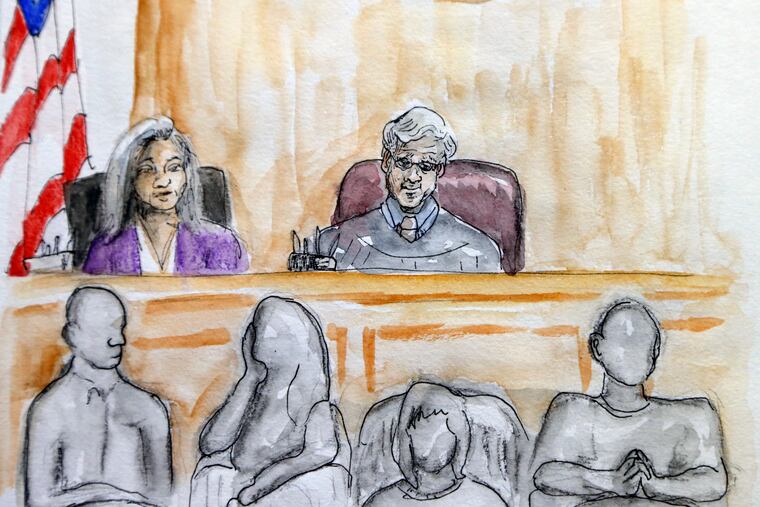Survivors give voice to terror at Charlottesville rally
James A. Fields Jr. is accused of intentionally driving his car into counterprotesters at 'Unite the Right' rally.

CHARLOTTESVILLE, Va. - As the murder trial of James Fields Jr. resumed here Friday, several survivors injured by his alleged act of vehicular rage were summoned to testify, including Jeanne Peterson, who is a long way from healed after 15 months.
Gripping a cane, Peterson, 38, entered the courtroom in short, labored steps. A prosecutor and a bailiff helped steady her as she limped to the witness stand.
"His front and back tires ran over my legs," Peterson told the jury at one point, as a sequence of photos of her wounds appeared on a video screen. "I've had five surgeries so far," she said haltingly. "I'm having a sixth next year."
On Aug. 12, 2017, when Fields, a self-professed neo-Nazi, rammed his speeding car into a crowd of counterprotesters during a white supremacists rally in this city, the crash killed Heather D. Heyer, 32, described by friends as an advocate for social justice. Her death is the main focus of Fields' trial on a charge of first-degree murder.
Additionally, he is accused of multiple felonies related to eight of 35 others who were hurt, some grievously. One of them was Peterson, who testified that she only recently began walking short distances if "it's not slippery." Otherwise she uses a wheelchair.
Just as "Charlottesville" has become a shorthand term for emboldened ethno-fascism in the United States, Heyer's name is synonymous with the lasting grief caused by a public outpouring of racist and anti-Semitic hate. On Friday, the second day of testimony in the trial, Peterson and three other prosecution witnesses gave voice to the pain and terror of that August day.
One by one, the evidence photos of Peterson's injuries were shown on the screen, with Peterson narrating, her voice alternately emotional and matter-of-fact.
Exhibit No. 129: "Red marks all over my body . . . "
Exhibit No. 132: "That still hurts a lot. Just the tiniest bit of movement . . . Three metal plates and roughly 18 screws . . . "
Exhibit No. 133, an X-ray: "A lot of crushed bones . . . They threw out anything that actually came out of my skin because of infection."
Fields, now 21, who drove to the "Unite the Right" rally from his apartment in Ohio, does not deny intentionally plowing his 2010 Dodge Challenger into the crowd of counterprotesters. But he has pleaded not guilty. His attorneys have said they will present evidence that Fields thought he was in danger of being hurt and needed to protect himself.
Amid violent clashes that day involving hundreds of white supremacists and their opponents, the group that included Heyer and Peterson was standing downtown at 4th and Water streets in the early afternoon. A pickup truck approached the gathering and pulled to the side of the road. A minivan then stopped on the street in front of the crowd, and a Toyota Camry stopped behind the van.
Fields' Dodge slammed into the rear of the Toyota at a high speed, setting off a chain-reaction crash and propelling bodies into the air.
Moments before the chaos, the minivan driver, Lizete Short, got out to take photos of the counterprotesters, leaving two girls, ages 5 and 10, in the vehicle with another adult. Suddenly, the van was propelled forward by the crash, hurling Short off her feet.
"I remember holding onto the hood," she testified. "I was afraid to let go . . . I think I was saying: 'Where are my kids? Where are my kids?'"
The Toyota driver, Tadrint Washington, "thought a bomb had gone off or something," she told the jury. "A big, big, big noise . . . I think I hit my head and blanked out."
Then a woman named Wednesday Bowie, a counterprotester in her 20s, took the witness stand. She was thrown in the air and bounced off the parked pickup truck.
"I lost consciousness either when I hit the black truck or when I hit the ground," she testified, as Assistant Commonwealth's Attorney Nina-Alice Antony put more photos on the video screen. "I remember being in pain immediately," Bowie said. "My pelvis was broken in six places at that time."
She also suffered three fractured vertebrae and a broken tailbone.
Exhibit No. 117: "That's a picture of me depicting the fracture of my right orbital socket. I still have nerve damage in that area."
Exhibit No. 115: "That's me just after they pulled me out of the street . . . When I broke my pelvis, one of the fractured pieces tore my right femoral artery, so I was bleeding out internally as I was waiting for the ambulance" - which arrived just in time for her.
Emergency surgery saved her life.